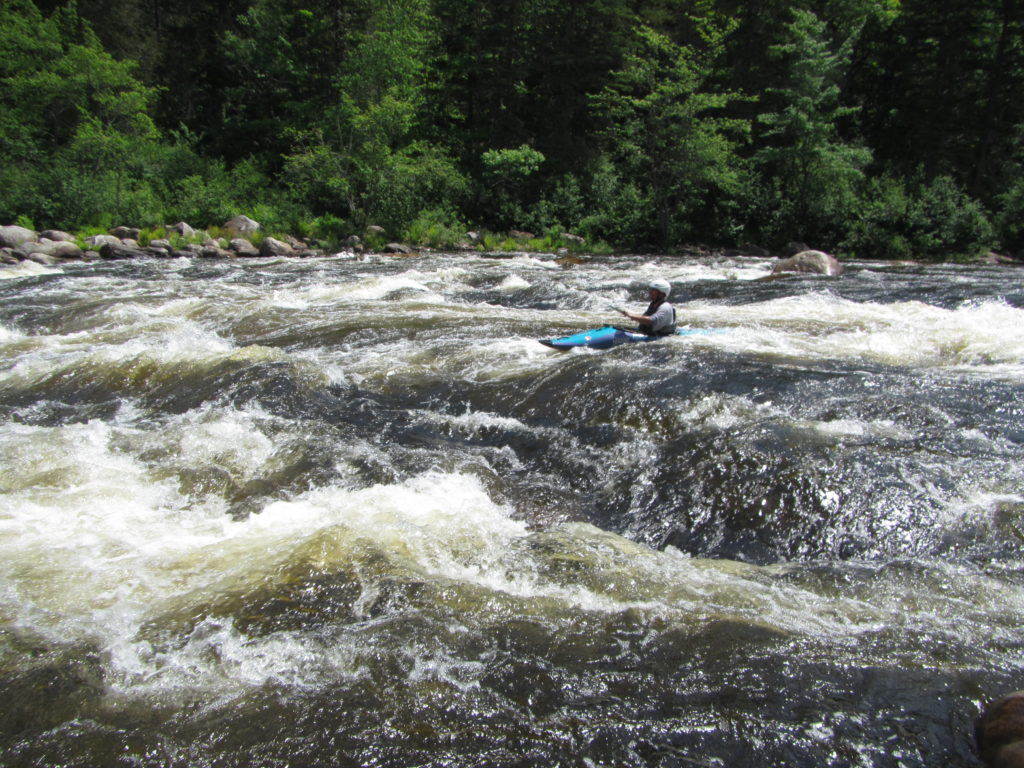Seniors Not Acting Their Age: Senior revelations on the Dead River

The first time I canoed the Dead River thirty-five years ago, the dam release was 1,000 cubic feet per second (CFS). The seemingly huge waves, mammoth holes, and powerful currents were the most intimidating whitewater I had ever experienced. As is true with many aspects of life, one’s perspective changes over time.
As the years passed, my skills improved, and I acquired higher performance canoes and kayaks. Elevated river levels became more appealing. When a friend inquired as to my favorite Dead River volume, I unflappably responded 5,500 CFS was my preference. She thought I was embellishing but at the time, it was the truth. The transformation had been augmented by paddling with more accomplished companions and learning to roll.
The importance of rolling a canoe or kayak in whitewater can’t be overstated. It’s a game changer. Without a roll, capsizing results in swimming. Canoes, kayaks, paddles, and other gear are lost unless quickly recovered in often difficult and sometimes dangerous circumstances. Experienced companions are invaluable in these predicaments but they can’t always assist with a rescue. In short, swimming in whitewater can run the spectrum from inconvenient to life threatening.
Once a roll is refined, the boater’s whitewater world changes dramatically. Initially, most devotees roll frequently as they challenge more difficult rapids. At some point, another realization enters the mind of the nascent paddler; being upside down in whitewater is a precarious position and rolls sometimes fail. For many including me, avoiding the need to roll has become a priority.
My friends and I have navigated the Dead scores of times. The volume has been as high as 15,000 CFS. Most have acquired sufficient expertise to play the river rather than paddle it, rolls rarely required. Nothing lasts forever and old age insidiously advances. Recently, I’ve found my self-assuredness waning, particularly doubts about my ability to roll in crucial situations. This spring, I resolved to attend scheduled pool rolling sessions in advance of the whitewater season to hone my skills. Alas, the pools were closed due to the pandemic.
When my friend Ryan announced he was organizing a weekend outing on the Dead River, my son Adam and I signed on. However, both of us were wary given our lack of rolling practice. The weather cooperated and the water temperature rose to 67 degrees at Adam’s home on Pleasant Pond. Meeting on a warm sunny afternoon two days before the trip, we both had successful calm water rolls. My confidence was buoyed.
Ryan did an outstanding job arranging a shuttle that provided for sufficient social distancing. The water level was 4,000 CFS when we arrived at the Spencer Stream launch during a rain shower. Several small groups of paddling friends were there along with a few million uninvited blackflies. The way the airborne scourge invaded my space, you’d have thought they owned the place.
The sixteen miles of almost continuous whitewater to West Forks is considered Class III/IV in difficulty at 4,000 CFS. The first rapid, Spencer, is relatively easy. The waves at the bottom seemed more substantial and challenging than I recalled. Uncharacteristically, I was anxious despite the encouraging rolling practice.
Progressing downriver, I found myself choosing conservative routes as the rapids increased in difficulty. Maneuvering through Minefield, Hayden’s, Elephant Rock, and Mile Long to a traditional rest stop above Upper and Lower Poplar Falls, I managed to avoid calamity despite a near upside down experience in a consequential hole on Mile Long.
While enjoying our respite, I realized I’d been descending the most difficult route on Class IV Lower Poplar for so many years I was no longer familiar with a more cautious alternative. Fortuitously, another paddler knew an easier passage and we successfully negotiated the complex rapid.
The next day, Adam, Ryan, friend Jason, and I were back for a 2,400 release. This time we embarked from the Gravel Pit access, shortening the trip to twelve miles. The lower level was just what the river doctor ordered. Relaxed and confident, I chose sporting descents on all of the difficult rapids. When we arrived at Lower Poplar, an old man and three kids rode the big breaking waves on river left, skirted around perilous Pyramid Rock, avoided an intimidating hole that is a notorious boat flipper, and caught a tiny eddy on the left bank. The remainder of the outing was concluded with ease completing a glorious day on the Dead, without rolling.
My new favorite senior level is 2,400 CFS!Author of “The Great Mars Hill Bank Robbery” and “Mountains for Mortals – New England,” Ron Chase resides in Topsham. Visit his website at www.ronchaseoutdoors.com or he can be reached at ronchaseoutdoors@comcast.net.


